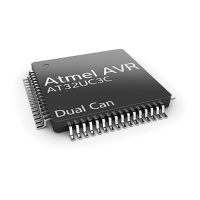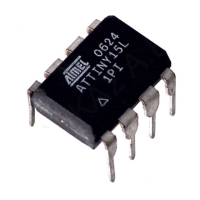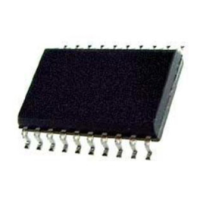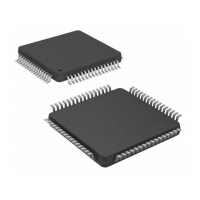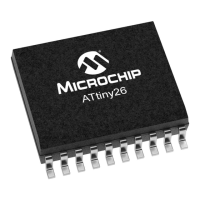433
8331B–AVR–03/12
Atmel AVR XMEGA AU
This ensures that the given command is executed and the operations finished before the start of
a new operation. The external programmer or application software must ensure that the NVM is
not addressed when it is busy with a programming operation.
Programming any part of the NVM will automatically block:
• All programming to other parts of the NVM
• All loading/erasing of the flash and EEPROM page buffers
• All NVM reads from external programmers
• All NVM reads from the application section
During self-programming, interrupts must be disabled or the interrupt vector table must be
moved to the boot loader sections, as described in ”Interrupts and Programmable Multilevel
Interrupt Controller” on page 134.
33.6 Flash and EEPROM Page Buffers
The flash memory is updated page by page. The EEPROM can be updated on a byte-by-byte
and page-by-page basis. flash and EEPROM page programming is done by first filling the asso-
ciated page buffer, and then writing the entire page buffer to a selected page in flash or
EEPROM.
The size of the page and page buffers depends on the flash and EEPROM size in each device,
and details are described in the device’s datasheet.
33.6.1 Flash Page Buffer
The flash page buffer is filled one word at a time, and it must be erased before it can be loaded.
When loading the page buffer with new content, the result is a binary AND between the existing
content of the page buffer location and the new value. If the page buffer is already loaded once
after erase the location will most likely be corrupted.
Page buffer locations that are not loaded will have the value 0xFFFF, and this value will then be
programmed into the corresponding flash page locations.
The page buffer is automatically erased after:
• A device reset
• Executing the write flash page command
• Executing the erase and write flash page command
• Executing the signature row write command
• Executing the write lock bit command
33.6.2 EEPROM Page Buffer
The EEPROM page buffer is filled one byte at a time, and it must be erased before it can be
loaded. When loading the page buffer with new content, the result is a binary AND between the
existing content of the page buffer location and the new value. If the EEPROM page buffer is
already loaded once after erase the location will most likely be corrupted.
EEPROM page buffer locations that are loaded will get tagged by the NVM controller. During a
page write or page erase, only targed locations will be written or erased. Locations that are not
targed will not be written or erased, and the corresponding EEPROM location will remain
unchanged. This means that before an EEPROM page erase, data must be loaded to the
